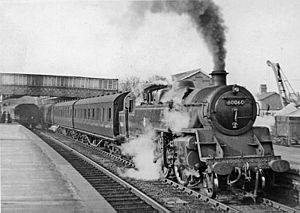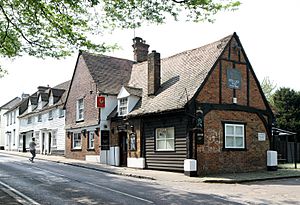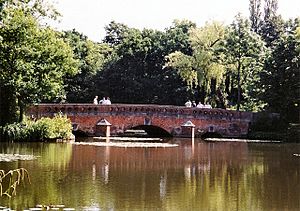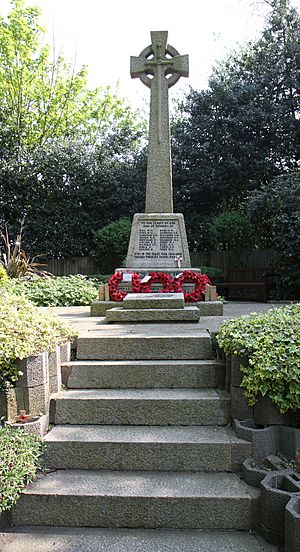Elstree facts for kids
Quick facts for kids Elstree |
|
|---|---|
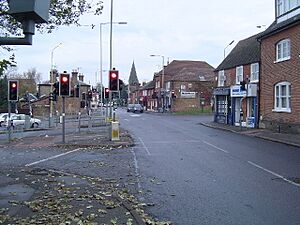 Watling Street, Elstree |
|
| Population | 5,110 (Ward, 2011) |
| OS grid reference | TQ175955 |
| Civil parish | |
| District |
|
| Shire county | |
| Region | |
| Country | England |
| Sovereign state | United Kingdom |
| Post town | BOREHAMWOOD |
| Postcode district | WD6 |
| Dialling code | 020 |
| Police | Hertfordshire |
| Fire | Hertfordshire |
| Ambulance | East of England |
| EU Parliament | East of England |
| UK Parliament |
|
Elstree is a large village in Hertfordshire, England. It is about 15 kilometres (9.3 miles) northwest of central London. The village is on the old Watling Street, a very old road that was used by the Romans. In 2011, about 5,110 people lived there. Elstree is part of a larger area called the civil parish of Elstree and Borehamwood. A civil parish is a local area with its own council.
Elstree is famous for its many film studios. Lots of movies and TV shows have been made here. For example, the TV soap opera EastEnders is filmed at BBC Elstree Centre. This studio is actually in the nearby town of Borehamwood.
The local newspaper for the area is the Borehamwood and Elstree Times. Elstree and Borehamwood are also "twinned" with towns in other countries. These include Offenburg in Germany, Fontenay-aux-Roses in France, and Huainan in China. Twinning means they have special friendly links.
Contents
Getting Around Elstree: Transport Links
Elstree & Borehamwood Train Station
The Elstree & Borehamwood railway station is on the Midland Main Line. This line connects London St Pancras to Bedford. The Midland Railway company built the station in 1868. It is just north of the 1,072-metre (1,172-yard) long Elstree Tunnels.
There were plans in the 1930s for an Elstree South Underground station. This would have been an extension of the Northern line, but it was never built.
Major Road Connections
The old A5 road, also known as Watling Street, runs right through Elstree village. In the village, it is called the A5183 road. It has different names as it goes through: Elstree Hill South, High Street, and Elstree Hill North.
An old building from the 1700s, Elstree Hill House, is on Elstree Hill South. It used to be home to the old Elstree School. People used to say that the hill roads were very straight. They thought this was because they were first used to slide timber down to London.
Elstree Aerodrome: A Local Airfield
Elstree Aerodrome is an airfield with a paved runway that is 655 metres (2,150 feet) long. It is mostly used by light aircraft and small turbine planes. It is also a main centre for helicopters in north London.
In the early 1930s, it was just a grass landing strip for a local country club. During World War II, a concrete runway was added. Wellington Bomber planes were changed here. After the war, the airfield was used to fly in food supplies.
London Transport's Aldenham Works
London Transport had a large workshop called Aldenham Works near Elstree. It opened in 1956 and closed in 1986. The site was later cleared and is now a big business park.
Elstree Grange Ships
The name Elstree has also been given to a series of ships called the Elstree Grange. These ships were owned by the Houlder Brothers company. One of them was sunk during the Second World War.
Famous Buildings in Elstree
Historic Grade II Listed Buildings
Elstree has several Grade II listed buildings. These are buildings that are important and protected because of their history or special design. Some are even Grade II*, meaning they are especially important.
- The Holly Bush public house, built in the 1400s.
- Aldenham House and its stable block, from around 1672.
- The Leys, a house built in 1901 by a Scottish architect named George Henry Walton.
The Manor Hotel
The Manor hotel is on Barnet Lane. It used to be called the Edgwarebury Hotel. This Tudor-style building dates back to 1540. It became a hotel in the 1960s. Many TV shows and films have used it, like the 1968 movie The Devil Rides Out. Famous people like Peter Sellers and Stanley Kubrick have stayed there. It was once the country home of Sir Trevor Dawson, who made weapons.
Other Notable Structures
An architect named Edward John May designed a house in Elstree. It was shown at the Royal Academy in 1887. St Nicholas Parish Church was designed by another English architect, Philip Charles Hardwick.
Schools and Education
Elstree is home to several schools. Aldenham School and Haberdashers' Boys' School are both independent public schools, which means they are fee-paying. There is also Haberdashers' School for Girls and St Nicholas Church of England V.A Primary School.
In the nearby town of Borehamwood, there are more schools. These include Hertswood Academy and Elstree Screen Arts Academy. This vocational school is linked with Elstree Studios.
There is also a Jewish high school called Yavneh College, Borehamwood. It opened in 2013. The Yavneh Schools governors recently opened a primary school on the same campus.
Past Schools in Elstree
A private school has been in Elstree since the 1780s.
Elstree School, a preparatory school for boys, was in Elstree from 1848 until 1938. It moved to Woolhampton before World War II.
Hillside School was in Elstree between 1874 and 1886. It later became Dorset House School in 1905.
Fun and Recreation
Sports Activities
Elstree Cricket Club started in 1878, but it no longer plays in the Herts Saracens League. Radlett Park Golf Club has 18 holes and was founded in 1984. It used to be called Elstree Golf & Country Club. It is actually closer to Elstree than to Radlett.
Hatch End Cricket Club also plays in Elstree. They are part of the Herts Saracens League.
Leisure and Walking Paths
Section 15 of the London Outer Orbital Path (called the London Loop) goes through Elstree. This path is a long walking route around London. Section 16 is a 16-kilometre (10-mile) walk from Elstree to Cockfosters.
Synagogues in the Area
Elstree has two synagogues. The Shtiebel is an ultra-orthodox synagogue. The Liberal Synagogue Elstree is just south of St. Nicholas' Church. Census data shows that a large part of Elstree's population is Jewish. There are also two United Synagogue shuls in the area. One is on Croxdale Road and the other is at Yavneh College, Borehamwood.
Parks and Green Spaces
Aldenham Country Park is a place for fun and also a centre for breeding rare farm animals. Part of the London Loop walk passes by it. In 1873, a nearby stream called Tykes Water was dammed to create Tykes Water lake. Tykes Water Bridge has appeared in films and TV shows. It is in the opening credits of the film Dracula A.D. 1972. It was also used in several episodes of the TV series The Avengers.
Elstree Reservoir: A Historic Lake
The dam for Elstree Reservoir was built in 1795 by French prisoners of war. An English painter, John Hassell, wrote about it. He said it looked like a beautiful lake. He also mentioned that the land around it used to be barren but had become rich pasture.
The reservoir was important because it could supply water to the Grand Junction Canal and the Paddington Canals if there was a drought. In 1886, photos of Elstree Reservoir were shown at an exhibition. During World War I, pilots used the reservoir for target practice. Sadly, in 1918, a pilot accidentally killed a local resident when his machine gun misfired.
Elstree's Rich History
What Does "Elstree" Mean?
The name "Elstree" comes from an old Anglo-Saxon phrase. It means "Tidwulf's Tree". This name was first written down in a document from around 786 AD. Some people think the "T" was lost over time.
In 1723, a writer named John Norden wrote that Elstree was also called "Eglestre". He thought it meant "grove of eagles". This suggests that eagles might have lived there a long time ago.
The famous author Daniel Defoe, who wrote Robinson Crusoe, described Elstree in 1748. He said it was a village on the Roman Watling Street. He noted it had lovely views over Middlesex and into Surrey.
In 1811, another writer, Daniel Lysons, said the name could mean "old road". This would make sense because it is on the ancient Watling Street.
The Battle of Elstree in the 5th Century
In the 400s, a British warlord named Vortigern and his sons fought in the Battle of Elstree. At that time, it was called the Battle of Ailestreu. During this battle, a Saxon leader named Horsa was killed. Some historians think this battle might be confused with the Battle of Aylesford in Kent.
Elstree from the 1500s to 1700s
The land of Elstree used to belong to the Abbey of St. Albans. After the Dissolution of the Monasteries by Henry VIII, the land was given to Anthony Denny.
Over the years, parts of the land were sold to different families. One part became known as the Manor of Boreham. In 1776, a law was passed to divide and enclose a large common land area called Boreham Wood Common.
In 1796, Daniel Lysons wrote that Elstree parish had about 3,000 acres of land. It was split almost equally between farmland and pasture. He noted that Boreham Wood, which was nearly 700 acres, was enclosed around 1778 and was then used for farming.
See also
 In Spanish: Elstree (Hertfordshire) para niños
In Spanish: Elstree (Hertfordshire) para niños



